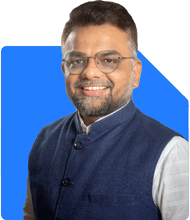Ramalingam Kalirajan |4138 Answers |Ask -Follow
Mutual Funds, Financial Planning Expert - Answered on Jun 29, 2024
He has an MBA in finance from the University of Madras and is a certified financial planner.
He is the director and chief financial planner at Holistic Investment, a Chennai-based firm that offers financial planning and wealth management advice.... more

I have 200000 as surplus amount, where can I invest it?
Understand Your Financial Goals and Risk Tolerance
First, it's essential to understand your financial goals.
What are you aiming to achieve with this investment?
Are you looking for long-term growth or short-term gains?
Also, your risk tolerance matters. Are you comfortable with high-risk, high-reward options, or do you prefer safer, lower-return investments?
Diversifying Your Investment
To ensure your money grows steadily and securely, it's crucial to diversify your investments. This means not putting all your money into one type of investment. Diversification helps spread the risk.
Let's look at a mix of options.
Mutual Funds for Steady Growth
Mutual funds are an excellent option for steady growth. They pool money from many investors to invest in a diversified portfolio of stocks, bonds, or other securities.
Choosing actively managed mutual funds can be beneficial. These funds are managed by professional fund managers who aim to outperform the market.
Benefits of Actively Managed Mutual Funds
Actively managed funds have the advantage of expert management. The fund manager makes decisions based on market conditions, aiming to maximize returns. This active management can potentially offer higher returns compared to index funds, which simply track the market.
Avoiding Direct Funds
While direct funds might seem attractive due to lower expense ratios, they require a hands-on approach. Direct funds mean you manage your investments without the help of a financial advisor. This can be time-consuming and complex.
Regular funds, on the other hand, involve investing through a Mutual Fund Distributor (MFD) with a Certified Financial Planner (CFP). They provide expert advice and ongoing management of your investments.
Fixed Deposits for Safety
If you prefer a low-risk option, fixed deposits (FDs) are a safe choice. FDs offer guaranteed returns and are not subject to market fluctuations. However, the returns are lower compared to mutual funds.
Balancing Risk and Reward with Hybrid Funds
Hybrid funds invest in both equities and debt instruments. This mix helps balance risk and reward. They offer higher returns than FDs but with lower risk compared to pure equity funds.
Benefits of Investing Through a CFP
Investing through a Certified Financial Planner (CFP) ensures you get professional advice tailored to your financial goals. A CFP can help you choose the right mix of investments, monitor their performance, and make adjustments as needed.
Disadvantages of Index Funds
Index funds track a market index and offer passive management. While they have lower fees, they do not aim to outperform the market. In volatile markets, index funds can underperform actively managed funds.
Systematic Investment Plans (SIPs)
For long-term investment, consider starting a Systematic Investment Plan (SIP). SIPs allow you to invest a fixed amount regularly in mutual funds. This helps in averaging out the cost and managing market volatility.
Emergency Fund
Before investing, ensure you have an emergency fund. This fund should cover at least 6-12 months of living expenses. It provides a financial cushion in case of unexpected expenses or job loss.
Gold as a Safe Haven
Gold is a traditional investment option in India. It acts as a hedge against inflation and currency fluctuations. Investing a portion of your surplus in gold can provide stability to your portfolio.
Public Provident Fund (PPF)
PPF is a government-backed savings scheme offering tax benefits and attractive returns. It’s a safe investment with a lock-in period of 15 years, suitable for long-term goals.
National Pension System (NPS)
For retirement planning, the National Pension System (NPS) is a good option. It offers tax benefits and helps build a retirement corpus. Investing in NPS ensures a regular income post-retirement.
Understanding ULIPs
If you have Unit Linked Insurance Plans (ULIPs), consider their high charges. ULIPs combine insurance and investment but often come with high fees like Fund Management Charges (FMC) and premium allocation charges.
Consider Surrendering ULIPs
If the charges are high and the returns are low, it might be wise to surrender your ULIPs. Reinvesting that money into mutual funds through a CFP can potentially offer better returns.
Reviewing Insurance Policies
If you hold traditional insurance policies, review their performance. Traditional policies often offer lower returns compared to other investment options. Consider switching to term insurance for pure risk cover and invest the difference in mutual funds.
Long-Term Wealth Creation
For long-term wealth creation, focus on equity mutual funds. They have the potential to offer higher returns compared to other asset classes.
Monitoring and Reviewing Investments
Regularly monitor and review your investments. This ensures they are aligned with your financial goals. Adjust your portfolio as needed based on market conditions and your risk tolerance.
Benefits of Professional Guidance
Professional guidance from a CFP ensures your investments are managed effectively. They provide valuable insights and help you make informed decisions.
Empathy and Understanding
I understand investing can be overwhelming. But, with the right guidance, you can make informed decisions that align with your financial goals. It's essential to stay informed and seek professional advice when needed.
Genuine Compliments
It's commendable that you're taking steps to secure your financial future. Your proactive approach will surely pay off in the long run.
Final Insights
Investing your Rs 2,00,000 surplus thoughtfully can significantly impact your financial future. Diversify your investments, focus on long-term growth, and seek professional guidance. Avoid high-cost investment options like ULIPs and opt for mutual funds through a CFP. Regularly review your portfolio to ensure it aligns with your goals.
Best Regards,
K. Ramalingam, MBA, CFP,
Chief Financial Planner,
www.holisticinvestment.in
You may like to see similar questions and answers below
Vivek Shah |60 Answers |Ask -Follow
Financial Planner - Answered on Jun 19, 2023
Ramalingam Kalirajan |4138 Answers |Ask -Follow
Mutual Funds, Financial Planning Expert - Answered on May 01, 2024
Ramalingam Kalirajan |4138 Answers |Ask -Follow
Mutual Funds, Financial Planning Expert - Answered on May 23, 2024
Ramalingam Kalirajan |4138 Answers |Ask -Follow
Mutual Funds, Financial Planning Expert - Answered on Jun 23, 2024
Nayagam P P |1078 Answers |Ask -Follow
Career Counsellor - Answered on Jul 01, 2024
Nayagam P P |1078 Answers |Ask -Follow
Career Counsellor - Answered on Jul 01, 2024
Nayagam P P |1078 Answers |Ask -Follow
Career Counsellor - Answered on Jul 01, 2024
Nayagam P P |1078 Answers |Ask -Follow
Career Counsellor - Answered on Jul 01, 2024
Nayagam P P |1078 Answers |Ask -Follow
Career Counsellor - Answered on Jul 01, 2024
Nayagam P P |1078 Answers |Ask -Follow
Career Counsellor - Answered on Jul 01, 2024
Nayagam P P |1078 Answers |Ask -Follow
Career Counsellor - Answered on Jul 01, 2024
Nayagam P P |1078 Answers |Ask -Follow
Career Counsellor - Answered on Jul 01, 2024
Dr Karthiyayini Mahadevan |833 Answers |Ask -Follow
General Physician - Answered on Jul 01, 2024
Dr Karthiyayini Mahadevan |833 Answers |Ask -Follow
General Physician - Answered on Jul 01, 2024





















